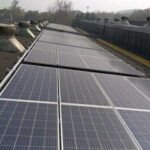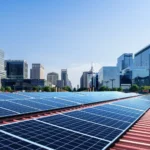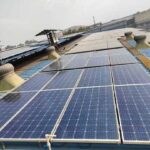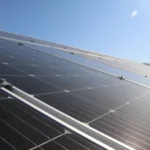Solar Inverters India: How to Choose the Best for Your Solar System
Solar Inverters India: How to Choose the Best for Your Solar System
With Indian government’s target of 100 GW by Solar power, 40 GW is targeted through Solar PV Rooftop Power Projects. As we all know Solar PV panels produce DC power, while the appliances that we use at our home require AC supply. Hence there is a need of a product that will convert DC into AC, so that Solar PV power can be used by us. This is done by using Inverters.
Inverters play an important role in Solar PV rooftop systems. After Solar PV modules, Inverters are the next most important component of Solar PV Rooftop Power Plants. Inverters can be of two types: On-Grid (Grid Tied) Inverters and Off-Grid (Stand-alone) inverters.
- Grid Tied inverters are used when the Solar PV Rooftop Power Plant at our premises is also connected to the Utility grid (DISCOM). Grid Tied inverters have security feature of anti-islanding. With the help of this feature, the Inverter disconnects the Solar PV power plant in situations when grid fails. This means that Grid Connected Solar PV system cannot be used when grid power (DISCOM supply) is not there.
- Off-grid (Stand-alone) Inverters are used for the Solar PV systems which are not connected to grid.
Many Solar Inverters are nowadays having feature of Remote Monitoring. With this feature one can keep track of performance of his Solar PV power plant from anywhere. Using an online portal we can see the power generation, generation curve and many more information.
Indian solar market is flooded with many kinds of Inverter Manufacturers and Suppliers, from local make to foreign make, from duplicate products to genuine products, from cheaper products to quality products. One needs to check and consult an expert before selecting these Inverters, because Inverter plays an important role in Solar PV power plant performance. Selecting a cheap and duplicate inverter may reduce the performance of your Solar PV system and or may add to the replacement cost because of short lifetime.
At the high end, there are few leading international manufacturers are SMA, Schneider, DELTA and ABB. These Inverter manufacturers give a large range of String and Central Solar Inverters starting from 3 KVA to 50 KVA and even bigger for central inverters. These inverters are typically high end and have all required features including remote monitoring.
Few other reputed brands such as L&T are also coming into the market with their Solar Inverters, but of higher capacities, generally for bigger plants.
These days the manufacturers of conventional inverter / UPS systems for our homes, such as Su-Kam, Luminous and Microtek are coming with their products called as Solar Inverters. These Inverters will take power from the solar PV modules and will charge the batteries. This will work same as our conventional inverters work, the difference comes that these inverters will charge the battery first from solar energy and if required or in case when solar energy is not available will charge the battery from the taking power from grid. These systems can be used where there are power cuts and one needs to store power. Many of these inverters may not have all the features like remote monitoring facility but will provide extra kit for a cost.
Apart from the above, there are many shops opened up for manufacturing Inverters. We will discuss about them in the next few articles.
Suggested Articles

How to Improve Solar Panel Performance for Optimal Energy Output
Performance degradation in solar panels reduces energy output over time. This guide explains how to factor in degradation when calculating annual yields, ensuring accurate estimates for residential, commercial, and industrial solar installations.

UP Government Incentive: Stamp Duty Exemption for Solar Land
Uttar Pradesh offers stamp duty exemption on land for solar projects, encouraging investment and growth in renewable energy.

Sanctioned Load & Rooftop Solar: Everything You Need to Know
Learn why sanctioned load is crucial before rooftop solar installation. Understand its role, process, and impact on solar panel efficiency and subsidy eligibility.

India Solar Energy Policies: Key Updates and Government Initiatives
India is one of the leading countries in terms of solar energy development, having become the fastest-growing market for solar power globally.

Top 10 Sustainable Building Practices to Consider for Your Construction Business
The construction industry is embracing sustainability like never before. From smart design to renewable energy use, these top 10 practices ensure businesses stay competitive, compliant, and environmentally responsible.

Solar Rooftop Projects: Benefits of Intentional Islanding for Power Backup
Discover the role of intentional islanding in solar rooftop projects. Ensure continuous power supply, system safety, and reliable energy even during grid failures.

Everything You Need to Know About Solar PV Modules
Solar PV modules explained: how they generate electricity, their benefits, and why they’re key to renewable energy growth.

UP Discoms Propose 9.21% Electricity Tariff Hike for 2015-16
Uttar Pradesh Discoms propose a 9.21% increase in electricity tariffs for 2015-16, impacting residential, commercial, and industrial consumers across the state.

Fire Hazard in a Solar Setup at Rice Mill, Kaithal – Case Study and Safety Insights
A recent fire incident at a rice mill in Kaithal highlights the critical importance of safety in solar installations. This case study analyzes the root causes, system faults, and preventive actions that can help industries avoid similar hazards in their solar setups.

Benefits of Solar Energy: Why Switching to Solar Makes Sense
Switching to solar energy offers numerous benefits, from lowering electricity bills to reducing your carbon footprint. This guide explores how solar power supports sustainable living, provides cost savings, and creates a cleaner environment for homes, businesses, and industries. Learn why adopting solar energy is not just smart, but essential for a greener future.